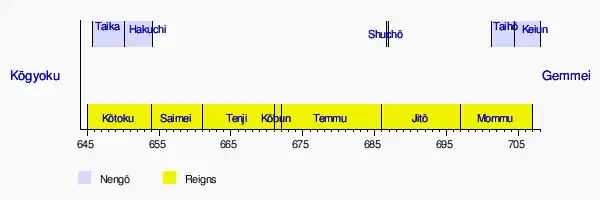Shuchō
Shuchō (朱鳥), alternatively read as Suchō or Akamitori, was a Japanese era name (年号, nengō, "year name") after a gap following Hakuchi (650–654) and before another gap lasting until Taihō (701–704). This Shuchō period briefly spanned a period of mere months, June through September 686.[1] The reigning sovereigns were Tenmu-tennō (天武天皇) and Jitō-tennō (持統天皇).[2]
| Part of a series on the |
| History of Japan |
|---|
 |
History
In 686, also known as Shuchō gannen (朱鳥元年), the new era name referred to the red bird of the south, which was one of the Chinese directional animals.[3] The nengō did not survive Emperor Tenmu's death. The era ended with the accession of Temmu's successor, Empress Jitō.
Timeline
| Timelines of early Japanese nengō and Imperial reign dates |
|---|
 |
The system of Japanese era names was not the same as Imperial reign dates.
Events of the Shuchō era
- 686 (Shuchō 1, 9th day of the 9th month): Emperor Tenmu dies[4]
- 686 (Shuchō 1, 2nd day of the 10th month): rebellion of Prince Ōtsu discovered; he and conspirators are arrested[4]
- 686 (Shuchō 1, 3rd day of the 10th month): Prince Ōtsu commits suicide[4]
- 686 (Shuchō 1, 16th day of the 11th month): Princess Ōku, Prince Ōtsu's sister, is removed from position at Ise Shrine[5]
- 686 (Shuchō 1, 17th day of the 11th month): earthquake[5]
Notes
- Nussbaum, Louis-Frédéric. (2005). "Shuchō" in Japan Encyclopedia, p. 889, p. 889, at Google Books; n.b., Louis-Frédéric is pseudonym of Louis-Frédéric Nussbaum, see Deutsche Nationalbibliothek Authority File Archived 2012-05-24 at archive.today.
- Titsingh, Isaac. (1834). Annales des empereurs du japon, pp. 58–59; Brown, Delmer et al. (1979). Gukanshō, pp. 268–269.
- Bender, Ross. (2009). "The Suppression of the Tachibana Naramaro Conspiracy," Japanese Journal of Religious Studies 37/2:223–245; compare mirrored full-text Archived 2012-02-12 at the Wayback Machine; retrieved 2012-10-23.
- Hioki (2007:195)
- Hioki (2007:196)
References
- Brown, Delmer M. and Ichirō Ishida, eds. (1979). Gukanshō: The Future and the Past. Berkeley: University of California Press. ISBN 978-0-520-03460-0; OCLC 251325323
- Hioki, Eigō. (2007). Chronology of New National History, Vol. 1 (新・国史大年表. 第1卷, Shin kokushi dainenpyō. dai 1 kan). Tōkyō: Kokusho Kankōkai. ISBN 9784336048264 ISBN 4336048266; OCLC 676118585
- Nussbaum, Louis-Frédéric and Käthe Roth. (2005). Japan encyclopedia. Cambridge: Harvard University Press. ISBN 978-0-674-01753-5; OCLC 58053128
- Titsingh, Isaac. (1834). Nihon Ōdai Ichiran; ou, Annales des empereurs du Japon. Paris: Royal Asiatic Society, Oriental Translation Fund of Great Britain and Ireland. OCLC 5850691
- Varley, H. Paul. (1980). A Chronicle of Gods and Sovereigns: Jinnō Shōtōki of Kitabatake Chikafusa. New York: Columbia University Press. ISBN 9780231049405; OCLC 6042764
External links
- National Diet Library, "The Japanese Calendar" -- historical overview plus illustrative images from library's collection
This article is issued from Wikipedia. The text is licensed under Creative Commons - Attribution - Sharealike. Additional terms may apply for the media files.